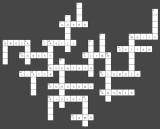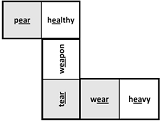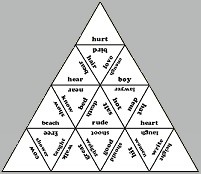I use these lessons for learners at A2 to B2 levels (depending on their needs, level of support and time available), but you know your students best, so use your judgement over whether the level is suitable or needs adapting.
 Silent letters (jigsaw crossword)
Silent letters (jigsaw crossword)
This is a lesson for A2 students (taking up to 1 hour) which aims to review and expand vocabulary and increase awareness of silent letters in spelling and pronunciation. It also involves lots of speaking. If you are familiar with jigsaw crosswords, I don't need to explain further, but full instructions (with a lead-in and follow-on activity) are on the pdf handout.
Sss, zzz and shhh
This is a short lesson (approximately 20 minutes) to present and practise the sounds sss, zzz and shhh which can be a problem for most nationalities. The main activity is a vocab-grab in which students take it in turns to read a list of words (with /s/, /z/ or /∫/ pronunciation), and the others race to find the word.
Short vowels: a, e, i, o and u or / æ e ɪ ɒ ʌ /
A short lesson plan to practise short vowel sounds (it works well as a 15-minute filler in a longer lesson). It looks simple, but often the difference between /æ/ and /e/ or /æ/ and /ʌ/ can cause problems (not to mention /t/ and /d/ at the ends of these words, and /ɪ/ mispronounced as /i:/).
Long vowels: a, e, i, o and u or / eɪ i: ɑɪ əʊ ju: /
This is a short(ish) lesson plan (approximately 30 minutes) to practise long vowel sounds with 'magic e'. Students learn how 'e' at the end of a word can change the pronunciation (e.g. hug → huge) and guess the spelling of words from their pronunciation. I would aim this at B1 because the vocabulary is mainly B1 (e.g. shave) and B2 level (e.g. blame), although a strong A2 class might enjoy the challenge.
Er, or and ah or /ɜ:/ /ɔ:/ and /ɑ:/
These are activities to introduce "er", "or" and "ah" sounds, with spelling hints and lots of follow-on practice. You could also try this big crossword (quite time consuming) or small crossword puzzle (if you have limited time) as follow-on practice.
Ear and Air pronunciation or /ɪə/ and /eə/
This is a handout to practise the /ɪə/ and /eə/ sounds.
 Pronunciation of words with "CH"
Pronunciation of words with "CH"
This is a lesson plan to present and practise the /tʃ/, /ʃ/ and /k/ pronunciation of the letters 'ch' at lower and upper levels. Don't be fooled - I thought my 16+ students would find the snap game childish, but it was actually quite challenging, and they responded really well to it!
Pronunciation of 'ou', 'o' and 'u'
This is a sound maze to encourage students to distinguish between the sounds for words with 'ou', 'o' and 'u' spelling.
 Pronunciation of 'ea'
Pronunciation of 'ea'
This is a lesson plan to present and practise seven different ways to pronounce the letters 'ea'. I would suggest simplifying it considerably if you plan to use it below B1 level! As a warmer, you get students to brainstorm words spelt with 'ea' (give them a point for each word they got that no one else did, or do a 'last-man-standing' kind of game where they have to sit down if they can't think of a word).
There is also a dominoes game here (it's quite challenging, even for good B1 level students) which you could try as a follow-on (perhaps as a review on another day).
Homophones
This is a worksheet to practise identifying and distinguishing between the spellings of 16 common homophones
 Vowel sounds puzzle
Vowel sounds puzzle
This is a pyramid jigsaw to test vowel sounds with confusing spellings (such as hurt and bird). British accents vary quite widely in their pronunciation of vowels (this puzzle is just for RP) so with higher levels you could discuss how pronunciation might change with region (e.g. laugh could be like heart or hat depending on where you come from). Answers are here.
To make your own similar puzzles, go to the Formulator Tarsia website, and download the puzzle making software. It's aimed at maths teachers but works well for language too.
